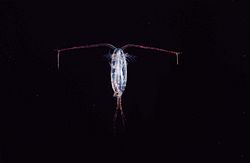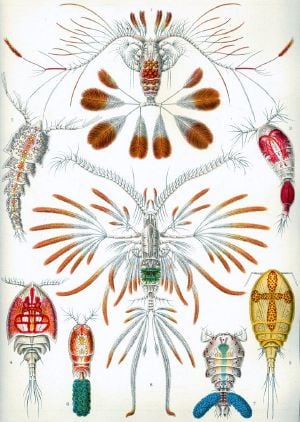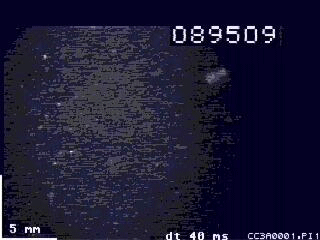Difference between revisions of "Copepod" - New World Encyclopedia
Rick Swarts (talk | contribs) (Added article from Wikipedia and credit and category tags) |
Rick Swarts (talk | contribs) (revised taxobox) |
||
| Line 1: | Line 1: | ||
{{Claimed}} | {{Claimed}} | ||
| − | {{ | + | {{Taxobox_begin | color = pink | name = Copepod}} |
| − | | color = pink | + | {{Taxobox_image | image = [[Image:copepodkils.jpg|250px|]] | caption = }} |
| − | | name = Copepod | + | {{Taxobox_begin_placement | color = pink}} |
| − | | image = copepodkils.jpg | + | {{Taxobox_regnum_entry | taxon = [[Animal]]ia}} |
| − | | | + | {{Taxobox_phylum_entry | taxon = [[Arthropod]]a}} |
| − | | | + | {{Taxobox_subphylum_entry | taxon = [[Crustacea]]}} |
| − | | | + | {{Taxobox_classis_entry | taxon = [[Maxillopoda]]}} |
| − | | | + | {{Taxobox_subclassis_entry | taxon = '''Copepoda'''}}<br/>{{Taxobox authority | author = [[Henri Milne-Edwards|H. Milne-Edwards]]* | date = 1840}} |
| − | | | + | {{Taxobox_end_placement}} |
| − | | | + | {{Taxobox_section_subdivision | color = pink | plural_taxon = Orders}} |
| − | | | ||
| − | | | ||
| − | | | ||
[[Calanoida]]<br> | [[Calanoida]]<br> | ||
| − | [[Cyclopoida]]<br> | + | [[Cyclopoida]]<br> |
[[Gelyelloida]]<br> | [[Gelyelloida]]<br> | ||
[[Harpacticoida]]<br> | [[Harpacticoida]]<br> | ||
[[Misophrioida]]<br> | [[Misophrioida]]<br> | ||
[[Monstrilloida]]<br> | [[Monstrilloida]]<br> | ||
| − | [[Mormonilloida]]<br> | + | [[Mormonilloida]]<br> |
[[Platycopioida]]<br> | [[Platycopioida]]<br> | ||
[[Poecilostomatoida]]<br> | [[Poecilostomatoida]]<br> | ||
[[Siphonostomatoida]] | [[Siphonostomatoida]] | ||
| − | }} | + | {{Taxobox_end}} |
'''Copepods''' are a group of small [[crustacean]]s found in the sea and nearly every [[fresh water|freshwater]] [[habitat (ecology)|habitat]]. Many species are [[plankton]]ic, but more are [[benthos|benthic]], and some continental species may live in limno-terrestrial habitats and other wet terrestrial places, such as swamps, under leaf fall in wet forests, bogs, springs, ephemeral ponds and puddles, damp moss, or water-filled recesses (phytothelmata) of plants such as [[bromeliad]]s and [[pitcher plant]]s. Many live underground in marine and freshwater caves, [[sinkhole]]s, or stream beds. Some copepods are [[parasite|parasitic]] and attach themselves to fish, sharks, marine mammals, and many kinds of invertebrates such as molluscs, tunicates, or corals. | '''Copepods''' are a group of small [[crustacean]]s found in the sea and nearly every [[fresh water|freshwater]] [[habitat (ecology)|habitat]]. Many species are [[plankton]]ic, but more are [[benthos|benthic]], and some continental species may live in limno-terrestrial habitats and other wet terrestrial places, such as swamps, under leaf fall in wet forests, bogs, springs, ephemeral ponds and puddles, damp moss, or water-filled recesses (phytothelmata) of plants such as [[bromeliad]]s and [[pitcher plant]]s. Many live underground in marine and freshwater caves, [[sinkhole]]s, or stream beds. Some copepods are [[parasite|parasitic]] and attach themselves to fish, sharks, marine mammals, and many kinds of invertebrates such as molluscs, tunicates, or corals. | ||
Revision as of 23:04, 16 January 2007
| Copepod | ||||||||||
|---|---|---|---|---|---|---|---|---|---|---|
 | ||||||||||
| Scientific classification | ||||||||||
| ||||||||||
| Orders | ||||||||||
|
Calanoida |
Copepods are a group of small crustaceans found in the sea and nearly every freshwater habitat. Many species are planktonic, but more are benthic, and some continental species may live in limno-terrestrial habitats and other wet terrestrial places, such as swamps, under leaf fall in wet forests, bogs, springs, ephemeral ponds and puddles, damp moss, or water-filled recesses (phytothelmata) of plants such as bromeliads and pitcher plants. Many live underground in marine and freshwater caves, sinkholes, or stream beds. Some copepods are parasitic and attach themselves to fish, sharks, marine mammals, and many kinds of invertebrates such as molluscs, tunicates, or corals.
Ecology
Planktonic copepods are important to global ecology and the carbon cycle; They are usually the dominant members of the zooplankton, and are major food organisms for small fish, whales, seabirds and other crustaceans such as krill in the ocean and in fresh water. Some scientists say they form the largest animal biomass on earth. They compete for this title with Antarctic krill (Euphausia superba). Because of their smaller size and relatively faster growth rates, however, and because they are more evenly distributed throughout more of the world's oceans, copepods almost certainly contribute far more to the secondary productivity of the world's oceans, and to the global ocean carbon sink than krill, and perhaps than all other groups of organisms together. The surface layers of the oceans are currently believed to be the world's largest carbon sink, absorbing about 2 billion tonnes of carbon a year, the equivalent to perhaps a third of human carbon emissions, thus reducing their impact. Many planktonic copepods feed near the surface at night, then sink into deeper water during the day. Their moulted exoskeletons, faecal pellets and respiration at depth all bring carbon to the deep sea.
Characteristics
Copepods are typically 1-2 mm long, with a teardrop shaped body and large antennae. Although like other crustaceans they have an armoured exoskeleton, they are so small that in most species this armour, and the entire body, is almost totally transparent. Copepods have a single eye, usually bright red and in the centre of the transparent head. Some polar copepods reach 1 cm. Most of the smaller copepods feed directly on phytoplankton, catching cells singly, but a few of the larger species are predators of their smaller relatives. Herbivorous copepods, particularly those in rich cold seas, store up energy from their food as oil droplets while they feed in the spring and summer plankton blooms. These droplets may take up over half of the volume of the body in polar species.

Many species have neurons surrounded by myelin, which is very rare among invertebrates (other examples are some annelids and malacostracan crustaceans like palaemonid shrimp and penaeids). Even rarer is the fact that the myelin is highly organized, resembling the well-organized wrapping found in vertebrates (Gnathostomata).
Some copepods are very evasive and can jump with extreme speed over a few millimeters (warning: takes some time to load to the correct speed):
This scene was scanned with the ecoSCOPE, an underwater high speed microscope. Very little is known about the details of these kinds of predator/prey interactions, in spite of their importance for global processes, because copepods are difficult to keep in the laboratory and lose most of their escape capacity, and herring are very fast, alert and evasive organisms and flee normal camera systems or scuba divers.
Classification
Copepods form a subclass belonging to the subphylum Crustacea (crustaceans). Some authors consider the copepods to be a full class. The group contains ten orders with some 14,000 described species. A scientist that studies copepods is a copepodologist.
Miscellaneous
Copepods are sometimes found in the public mains water supply, especially systems where the water is not filtered, such as New York City and Boston, Massachusetts. This is not usually a problem in treated water supplies. In some tropical countries, such as Peru and Bangladesh, a correlation has been found between copepods and cholera in untreated water, because the cholera bacteria attach to the surfaces of planktonic animals. The risk of cholera from infected water can be reduced by filtering out the copepods (and other matter), for example with a cloth filter.
For the use of copepods as bioindicators, see particle (ecology).
In popular culture
In the television series Spongebob Squarepants, the character Sheldon J. Plankton is a copepod.
External links
- Diversity and geographical distribution of pelagic copepoda
- Rudi Strickler copepod videos
- The virtual copepod page
- Copepod World
- Copepods and cholera in untreated water
- CNN report: New York Times: The Water's Fine, but Is It Kosher?
Credits
New World Encyclopedia writers and editors rewrote and completed the Wikipedia article in accordance with New World Encyclopedia standards. This article abides by terms of the Creative Commons CC-by-sa 3.0 License (CC-by-sa), which may be used and disseminated with proper attribution. Credit is due under the terms of this license that can reference both the New World Encyclopedia contributors and the selfless volunteer contributors of the Wikimedia Foundation. To cite this article click here for a list of acceptable citing formats.The history of earlier contributions by wikipedians is accessible to researchers here:
The history of this article since it was imported to New World Encyclopedia:
Note: Some restrictions may apply to use of individual images which are separately licensed.
